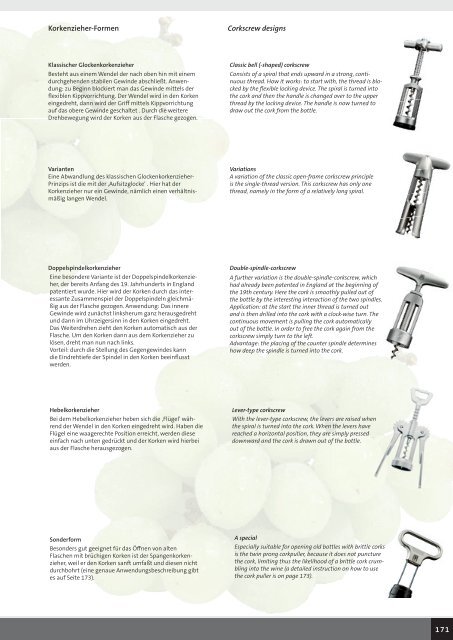Katalog als PDF herunterladen - Westmark
Katalog als PDF herunterladen - Westmark
Katalog als PDF herunterladen - Westmark
Erfolgreiche ePaper selbst erstellen
Machen Sie aus Ihren PDF Publikationen ein blätterbares Flipbook mit unserer einzigartigen Google optimierten e-Paper Software.
Korkenzieher-Formen<br />
Corkscrew designs<br />
Klassischer Glockenkorkenzieher<br />
Besteht aus einem Wendel der nach oben hin mit einem<br />
durchgehenden stabilen Gewinde abschließt. Anwendung:<br />
zu Beginn blockiert man das Gewinde mittels der<br />
flexiblen Kippvorrichtung. Der Wendel wird in den Korken<br />
eingedreht, dann wird der Griff mittels Kippvorrichtung<br />
auf das obere Gewinde geschaltet . Durch die weitere<br />
Drehbewegung wird der Korken aus der Flasche gezogen.<br />
Varianten<br />
Eine Abwandlung des klassischen Glockenkorkenzieher-<br />
Prinzips ist die mit der ‚Aufsitzglocke‘ . Hier hat der<br />
Korkenzieher nur ein Gewinde, nämlich einen verhältnismäßig<br />
langen Wendel.<br />
Variations<br />
A variation of the classic open-frame corkscrew principle<br />
is the single-thread version. This corkscrew has only one<br />
thread, namely in the form of a relatively long spiral.<br />
Doppelspindelkorkenzieher<br />
Eine besondere Variante ist der Doppelspindelkorkenzieher,<br />
der bereits Anfang des 19. Jahrhunderts in England<br />
patentiert wurde. Hier wird der Korken durch das interessante<br />
Zusammenspiel der Doppelspindeln gleichmäßig<br />
aus der Flasche gezogen. Anwendung: Das innere<br />
Gewinde wird zunächst linksherum ganz herausgedreht<br />
und dann im Uhrzeigersinn in den Korken eingedreht.<br />
Das Weiterdrehen zieht den Korken automatisch aus der<br />
Flasche. Um den Korken dann aus dem Korkenzieher zu<br />
lösen, dreht man nun nach links.<br />
Vorteil: durch die Stellung des Gegengewindes kann<br />
die Eindrehtiefe der Spindel in den Korken beeinflusst<br />
werden.<br />
Classic bell (-shaped) corkscrew<br />
Consists of a spiral that ends upward in a strong, conti-<br />
nuous thread. How it works: to start with, the thread is blocked<br />
by the flexible locking device. The spiral is turned into<br />
the cork and then the handle is changed over to the upper<br />
thread by the locking device. The handle is now turned to<br />
draw out the cork from the bottle.<br />
Double-spindle-corkscrew<br />
A further variation is the double-spindle-corkscrew, which<br />
had already been patented in England at the beginning of<br />
the 19th century. Here the cork is smoothly pulled out of<br />
the bottle by the interesting interaction of the two spindles.<br />
Application: at the start the inner thread is turned out<br />
and is then drilled into the cork with a clock-wise turn. The<br />
continuous movement is pulling the cork automatically<br />
out of the bottle. In order to free the cork again from the<br />
corkscrew simply turn to the left.<br />
Advantage: the placing of the counter spindle determines<br />
how deep the spindle is turned into the cork.<br />
Hebelkorkenzieher<br />
Bei dem Hebelkorkenzieher heben sich die ‚Flügel‘ während<br />
der Wendel in den Korken eingedreht wird. Haben die<br />
Flügel eine waagerechte Position erreicht, werden diese<br />
einfach nach unten gedrückt und der Korken wird hierbei<br />
aus der Flasche herausgezogen.<br />
Lever-type corkscrew<br />
With the lever-type corkscrew, the levers are raised when<br />
the spiral is turned into the cork. When the levers have<br />
reached a horizontal position, they are simply pressed<br />
downward and the cork is drawn out of the bottle.<br />
Sonderform<br />
Besonders gut geeignet für das Öffnen von alten<br />
Flaschen mit brüchigen Korken ist der Spangenkorkenzieher,<br />
weil er den Korken sanft umfaßt und diesen nicht<br />
durchbohrt (eine genaue Anwendungsbeschreibung gibt<br />
es auf Seite 173).<br />
A special<br />
Especially suitable for opening old bottles with brittle corks<br />
is the twin prong corkpuller, because it does not puncture<br />
the cork, limiting thus the likelihood of a brittle cork crumbling<br />
into the wine (a detailed instruction on how to use<br />
the cork puller is on page 173).<br />
171




